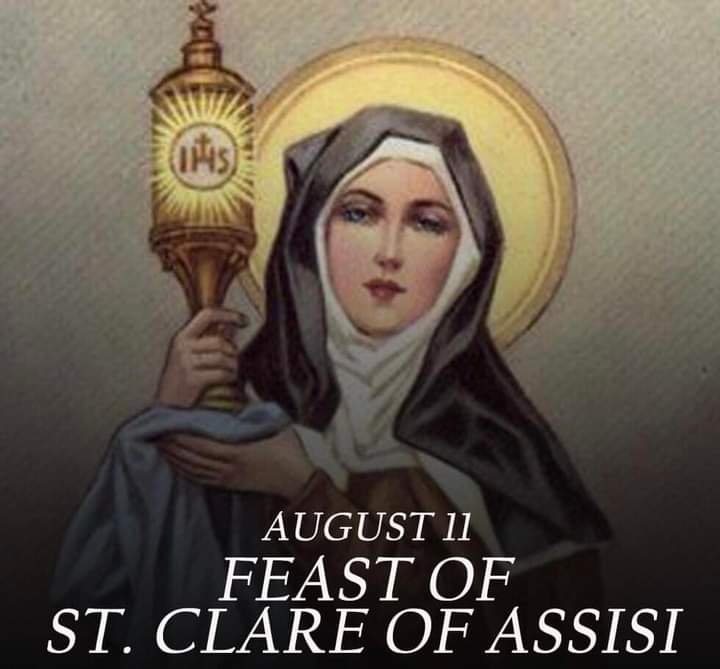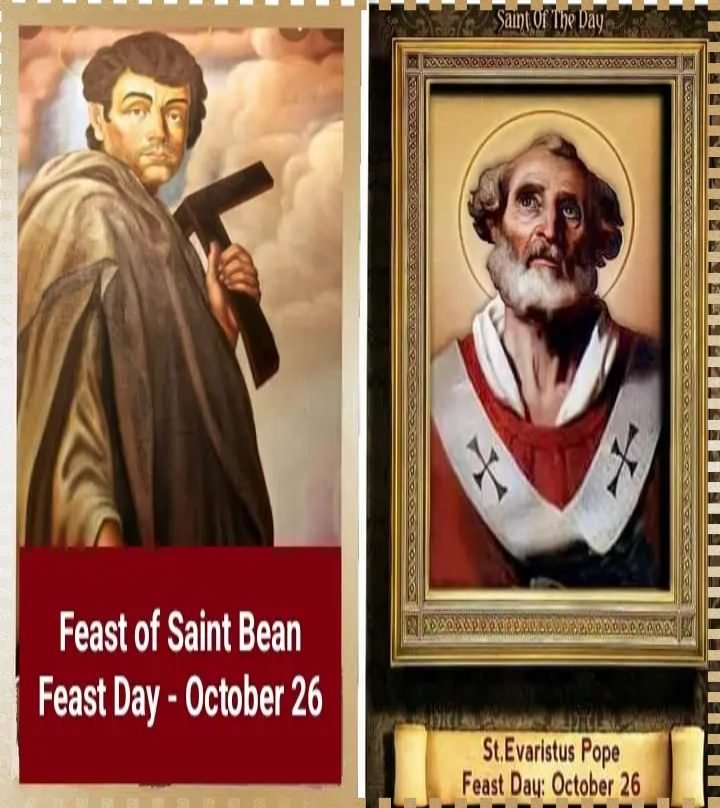FEAST OF SAINT CLARE OF ASSISI, VIRGIN
FEAST DAY – 11th AUGUST
Clare of Assisi (16 July 1194 – 11 August 1253), was an Italian saint and one of the first followers of Francis of Assisi. She founded the Order of Poor Ladies, a monastic religious order for women in the Franciscan tradition, and wrote their Rule of Life, the first set of monastic guidelines known to have been written by a woman. Following her death, the order she founded was renamed in her honour as the Order of Saint Clare, commonly referred to today as the Poor Clares. Her feast day is on 11 August.
Clare was born in Assisi during the High Middle Ages, the eldest daughter of Favarone or Favorino Sciffi, Count of Sasso-Rosso and his wife Ortolana. Traditional accounts say that Clare’s father was a wealthy representative of an ancient Roman family, who owned a large palace in Assisi and a castle on the slope of Mount Subasio. Ortolana belonged to the noble family of Fiumi, and was a very devout woman who had undertaken pilgrimages to Rome, Santiago de Compostela and the Holy Land.
Later in life, Ortolana entered Clare’s monastery, as did Clare’s sisters, Beatrix and Catarina (who took the name Agnes and was later declared a saint herself). As a child, Clare was devoted to prayer. Although there is no mention of this in any historical record, it is assumed that Clare was to be married in line with the family tradition.
However, as a teen she heard Francis preach during a Lenten service in the church of San Giorgio at Assisi and asked him to help her to live after the manner of the Gospel. On the evening of Palm Sunday, 20 March 1212, she left her father’s house and accompanied by her aunt Bianca and another companion proceeded to the chapel of the Porziuncula to meet Francis.

There, her hair was cut, and she exchanged her rich gown for a plain robe and veil. Francis placed Clare in the convent of the Benedictine nuns of San Paulo, near Bastia. Her father attempted to force her to return home. She clung to the altar of the church and threw aside her veil to show her cropped hair. She resisted each attempt, professing that she would have no other husband but Jesus Christ.
In order to provide the greater solitude Clare desired, a few days later Francis sent her to Sant’ Angelo in Panzo, another monastery of the Benedictine nuns on one of the flanks of Subasio. Clare was soon joined by her sister Catarina, who took the name Agnes. They remained with the Benedictines until a small dwelling was built for them next to the church of San Damiano, which Francis had repaired some years earlier.
Other women joined them, and they were known as the “Poor Ladies of San Damiano”. They lived a simple life of poverty, austerity and seclusion from the world, according to a Rule which Francis gave them as a Second Order (Poor Clares). San Damiano became the centre of Clare’s new religious order, which was known in her lifetime as the “Order of Poor Ladies of San Damiano”.
San Damiano is traditionally considered the first house of this order; it may have been affiliated with an existing network of women’s religious houses organised by Hugolino (who later became Pope Gregory IX). Hugolino wanted San Damiano as part of the order he founded because of the prestige of Clare’s monastery.

San Damiano emerged as the most important house in the order, and Clare became its undisputed leader. By 1263, just ten years after Clare’s death, the order had become known as the Order of Saint Clare. In 1228, when Gregory IX offered Clare a dispensation from the vow of strict poverty, she replied: “I need to be absolved from my sins, but not from the obligation of following Christ.”
Accordingly, the Pope granted them the Privilegium Pauperitatis — that nobody could oblige them to accept any possession. Unlike the Franciscan friars, whose members moved around the country to preach, Saint Clare’s sisters lived in enclosure, since an itinerant life was hardly conceivable at the time for women.
Their life consisted of manual labour and prayer. The nuns went barefoot, slept on the ground, ate no meat and observed almost complete silence. For a short period, the order was directed by Francis himself. Then in 1216, Clare accepted the role of abbess of San Damiano. As abbess, Clare had more authority to lead the order than when she was the prioress and required to follow the orders of a priest heading the community.
Clare defended her order from the attempts of prelates to impose a rule on them that more closely resembled the Rule of Saint Benedict than Francis’ stricter vows. Clare sought to imitate Francis’ virtues and way of life so much so that she was sometimes titled alter Franciscus, another Francis. She also played a significant role in encouraging and aiding Francis, whom she saw as a spiritual father figure, and she took care of him during his final illness.

After Francis’s death, Clare continued to promote the growth of her order, writing letters to abbesses in other parts of Europe and thwarting every attempt by each successive pope to impose a rule on her order which weakened the radical commitment to corporate poverty she had originally embraced. Clare’s Franciscan theology of joyous poverty in imitation of Christ is evident in the rule she wrote for her community and in her four letters to Agnes of Prague.
As Holy Roman Emperor Frederick II battled Pope Gregory IX for control of Italy during the Crusades era, separately in September 1240 and June 1241, a pair of armies attacked the monastery of San Damiano and the town of Assisi. Both targets were successfully defended as Clare prayed to Christ, present in the Blessed Sacrament.
In her later years, Clare endured a long period of poor health. She died on 11 August 1253 at the age of 59. Her last words are reported to have been, “Blessed be You, O God, for having created me.” On 9 August 1253, two days before her death, the papal bull Solet annuere of Pope Innocent IV confirmed that Clare’s rule would serve as the governing rule for Clare’s Order of Poor Ladies.
Her remains were interred at the chapel of San Giorgio while a church to hold her remains was being constructed. At her funeral, Pope Innocent IV insisted the friars perform the Office for the Virgin Saints as opposed to the Office for the Dead. This move by Pope Innocent ensured that the canonization process for Clare would begin shortly after her funeral.

Pope Innocent was cautioned by multiple advisers against having the Office for the Virgin Saints performed at Clare’s funeral. The most vocal of these advisers was Cardinal Raynaldus who would later become Pope Alexander IV, who in two years time would canonize Clare. At Pope Innocent’s request the canonization process for Clare began immediately.
While the whole process took two years, the examination of Clare’s miracles took just six days. On 26 September 1255, Pope Alexander IV canonized Clare as Saint Clare of Assisi. Construction of the Basilica of Saint Clare was completed in 1260, and on 3 October of that year Clare’s remains were transferred to the newly completed basilica where they were buried beneath the high altar.
In further recognition of the saint, Pope Urban IV officially changed the name of the Order of Poor Ladies to the Order of Saint Clare in 1263. Some 600 years later in 1872, Clare’s relics were transferred to a newly constructed shrine in the crypt of the Basilica of Saint Clare, where her relics can still be venerated today.
Clare was canonized on 26 September 1255 by Pope Alexander IV, and her feast day was immediately inserted in the General Roman Calendar for celebration on 12 August, the day after her death, as 11 August was already assigned to Saints Tiburtius and Susanna, two 3rd-century Roman martyrs. The celebration was ranked as a Double (as in the Tridentine Calendar) or, in the terminology adopted in 1960, a Third-Class Feast (as in the General Roman Calendar of 1960).


The 1969 calendar revision removed the feast of Tiburtius and Susanna from the calendar, finally allowing the memorial of Saint Clare to be celebrated on 11 August, the day of her death. Construction of the Basilica di Santa Chiara began a year after Clare’s canonization, and her remains were transferred there on 3 October 1260 from the church of St George, also in Assisi. Her bones are now in the crypt at the Basilica, having been rediscovered in 1850.
In art, Clare is often shown carrying a monstrance or pyx, in commemoration of the occasion when she warded away the invading soldiers of Frederick II at the gates of her convent by displaying the Blessed Sacrament and kneeling in prayer. Pope Pius XII designated Clare as the patron saint of television in 1958 on the basis that when she was too ill to attend Mass, she had reportedly been able to see and hear it on the wall of her room.
There are traditions of bringing offerings of eggs to the Poor Clares for their intercessions for good weather, particularly for weddings. This tradition remains popular in the Philippines, particularly at the Real Monasterio de Santa Clara in Quezon City and in the town of Obando, Bulacan.
PRAYER
Saint Clare of Assisi, you chose a thorough and absolute form of love of God as a cloistered nun and opposed and overcame all obstacles threatening and surrounding the passion of your love of Christ.
May your example of edification of the Faith, inspire all Catholics, especially female religious, to practice total surrender and submission of their lives around God, His Son, and His Church.

Saint Clare of Assisi, pray for us.
+++++++++++++++++++++++++++++++++
FEAST OF SAINT PHILOMENA, VIRGIN AND MARTYR
FEAST DAY – 11th AUGUST

Saint Philomena is the patron saint against barrenness, infertility, sterility, against bodily ills, against mental illness, against sickness, sick people, babies, infants, newborns, toddlers, children, young people, youth, Children of Mary, desperate, forgotten, lost or impossible causes, Living Rosary, orphans, poor people, priests, prisoners, students, school children, test takers.
The very name of Philomena contains the words: filia luminis, daughter of light. Little is known of her life, and the information we have was received by private revelation from her. She was martyred at about age 14 in the early days of the Church.
In 1802 the remains of a young woman were found in the catacomb of St. Priscilla on the Via Salaria, Rome, Italy. It was covered by stones, the symbols on which indicated that the body was a martyr named St. Philomena. The bones were exhumed, cataloged, and effectively forgotten since there was so little known about the person.
In 1805 Canon Francis de Lucia of Mugnano, Italy was in the Treasury of the Rare Collection of Christian Antiquity (Treasury of Relics) in the Vatican. When he reached the relics of Saint Philomena he was suddenly struck with a spiritual joy, and requested that he be allowed to enshrine them in a chapel in Mugnano.

After some disagreements, settled by the cure of Canon Francis following prayers to Philomena, he was allowed to translate the relics to Mugnano. Miracles began to be reported at the shrine including cures of cancer, healing of wounds, and the Miracle of Mugnano in which Venerable Pauline Jaricot was cured a severe heart ailment overnight.
Philomena became the only person recognized as a Saint solely on the basis of miraculous intercession as nothing historical was known of her except her name and the evidence of her martyrdom. It is said that Saint Philomena revealed her story to three people who did not know one another and who resided in different parts of the world.
These private revelations unveiled the story of Saint Philomena’s life in great detail and were amazingly identical accounts. One of the most well-known recipients of this revelation was the Foundress of the Oblates of Our Lady of Sorrows, Mother Maria Luisa di Gesù, a Dominican Tertiary.
St. Philomena came to her and told her she was the daughter of a Greek king who converted to Christianity. Her parents had been unable to conceive a child, and after many prayers to the gods, realized that their prayers were going unanswered because the gods they had been praying to were false and did not exist. They converted to Christianity and bore a daughter. They named her Philomena, meaning “lover of light.” Philomena was raised in the Christian faith and developed a strong love for Christ.
At the age of thirteen, Philomena traveled with her parents to Rome. The Roman emperor Diocletian had threatened Philomena’s father with a war, and he had to meet with the emperor to attempt to make peace. When her family was admitted to an audience with Emperor Diocletian, the emperor’s eyes fell upon Philomena at once. He was taken by her beauty and insisted that she should marry him.
Philomena refused, though, stating that she had promised herself to God alone and would marry no man. Overcome with anger at being rejected, the emperor had Philomena thrown into a dungeon. Emperor Diocletian made several other attempts to entice Philomena to marry him – and every time she stated she would not marry him because she had consecrated herself to God alone.
The emperor had her tortured severely, almost to the point of death. She was bound to a pillar and scourged mercilessly. After the torture was finished, the emperor had her brought back to the prison to die. However, she was given strength by God and continued to live.

In another attempt to kill her, Emperor Diocletian had his men take Philomena to the river and tie a large anchor around her neck. He was sure she would not survive this attempt at drowning, and that this would terrify her into agreeing to marry him. He was wrong.
Philomena again rejected his offer of marriage, and so was thrown in the river to drown. Yet, she survived. Frustrated, the emperor had his men throw her in the river again. And once more, she survived.
Wholly angered at his inability to convince her to marry him, as well as his inability to kill her, Emperor Diocletian ordered his men to shoot her with arrows until she was dead. However, still Philomena survived.

The people of Rome who witnessed these events were amazed at the faith of Philomena in the face of peril and possible death. She was just a young girl, and yet, her faith was strong enough to carry her through the pain of the torture – and even to save her life from the many attempts at killing her!
Seeing this caused many Romans to begin believing in the power of the One, True God, and they converted to Christianity because of Philomena’s example.
Emperor Diocletian became even more enraged at finding out that the people of Rome were turning from the false gods and converting to Christianity.
Determined to put a stop to his embarrassment in being unable to both convince Philomena to marry him and to kill her for rejecting him, Emperor Diocletian ordered that St. Philomena should be beheaded.

Philomena was martyred for her faith and singular devotion to Christ in 304. The nun’s account states Philomena was born on January 10 and was killed on August 10.
An inscription near her tomb read: “Peace be with thee Philomena”, along with drawing of 2 anchors, 3 arrows and a palm. It was a common custom of the early Christians to leave symbols and signs such as these, if somebody they thought to be a saint, died. She is known for the extraordinary miracles that occur when she is asked to pray for us.
PRAYER
To thee, O Great St. Philomena, we turn in our afflictions, for thou art truly worthy of the title, “Powerful with God”, who stimulates the faith and courage of the faithful, Pray for us! St. Philomena, whose name is glorified in Heaven and feared in Hell, Pray for us!








